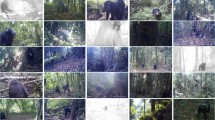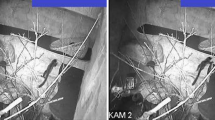Abstract
The latest advances in artificial intelligence technology have opened doors to the video analysis of complex behaviours. In light of this, ethologists are actively exploring the potential of these innovations to streamline the time-intensive behavioural analysis process using video data. Several tools have been developed for this purpose in primatology in the past decade. Nonetheless, each tool grapples with technical constraints. To address these limitations, we have established a comprehensive protocol designed to harness the capabilities of a cutting-edge artificial intelligence-assisted software, LabGym. The primary objective of this study was to evaluate the suitability of LabGym for the analysis of primate behaviour, focusing on Japanese macaques as our model subjects. First, we developed a model that accurately detects Japanese macaques, allowing us to analyse their actions using LabGym. Our behavioural analysis model succeeded in recognising stone-handling-like behaviours on video. However, the absence of quantitative data within the specified time frame limits the ability of our study to draw definitive conclusions regarding the quality of the behavioural analysis. Nevertheless, to the best of our knowledge, this study represents the first instance of applying the LabGym tool specifically for the analysis of primate behaviours, with our model focusing on the automated recognition and categorisation of specific behaviours in Japanese macaques. It lays the groundwork for future research in this promising field to complexify our model using the latest version of LabGym and associated tools, such as multi-class detection and interactive behaviour analysis.








Similar content being viewed by others
Data availability
Codes are available on Github: https://github.com/umyelab/LabGym. Data are available on Zenodo: https://doi.org/10.48550/arXiv.2310.07812.
References
Altmann J (1974) Observational study of behaviour: sampling methods. Behaviour 49:227–267
Anderson DJ, Perona P (2014) Toward a science of computational ethology. Neuron 84:18–31
Barnard CJ (2012) Animal behaviour: ecology and evolution. Springer Science & Business Media
Bharati P, Pramanik A (2020) Deep learning techniques–R-CNN to mask R-CNN: a survey. Comput Intell Pattern Recognit Proc CIPR 2019:657–668
Bohnslav JP, Wimalasena NK, Clausing KJ et al. (2021) DeepEthogram, a machine learning pipeline for supervised behaviour classification from raw pixels. ELife 10:e63377. https://doi.org/10.7554/eLife.63377
Brakes P, Dall SRX, Aplin LM et al. (2019) Animal cultures matter for conservation. Science 363:1032–1034. https://doi.org/10.1126/science.aaw3557
Chakravarty P, Cozzi G, Dejnabadi H et al. (2020) Seek and learn: automated identification of microevents in animal behaviour using envelopes of acceleration data and machine learning. Methods Ecol Evol 11:1639–1651
Charpentier MJE, Harté M, Poirotte C et al. (2020) Same father, same face: deep learning reveals selection for signaling kinship in a wild primate. Sci Adv 6:eaba3274. https://doi.org/10.1126/sciadv.aba3274
De Cesarei A, Cavicchi S, Cristadoro G, Lippi M (2021) Do humans and deep convolutional neural networks use visual information similarly for the categorisation of natural scenes? Cogn Sci 45:e13009
Dutta A, Gupta A, Zissermann A (2016) VGG image annotator (VIA). URL: https://www.robots.ox.ac.uk/~vgg/software/via/
Enquist M, Ghirlanda S (2005) Neural networks and animal behaviour. Princeton University Press
Gris KV, Coutu J-P, Gris D (2017) Supervised and unsupervised learning technology in the study of rodent behaviour. Front Behav Neurosci 11:141
Gu J, Wang Z, Kuen J et al. (2018) Recent advances in convolutional neural networks. Pattern Recogn 77:354–377
Hardin A, Schlupp I (2022) Using machine learning and DeepLabCut in animal behaviour. Acta Ethologica 25:125–133
Hu Y, Ferrario CR, Maitland AD et al. (2023) LabGym: quantification of user-defined animal behaviours using learning-based holistic assessment. Cell Rep Methods. https://doi.org/10.1016/j.crmeth.2023.100415
Huffman MA, Quiatt D (1986) Stone handling by Japanese macaques (Macaca fuscata): implications for tool use of stone. Primates 27:413–423
Huffman MA, Leca JB, Nahallage CA (2010) Cultured Japanese macaques: a multidisciplinary approach to stone handling behaviour and its implications for the evolution of behavioural tradition in non-human primates. In: Nakagawa N, Nakamichi M, Sugiura H (eds) The Japanese Macaques. Springer, Tokyo
Huntingford F (2012) The study of animal behaviour. Springer Science & Business Media
Jabir B, Falih N, Rahmani K (2021) Accuracy and efficiency comparison of object detection open-source models. Int J Biomed Eng. https://doi.org/10.3991/ijoe.v17i05.21833
Kabra M, Robie AA, Rivera-Alba M et al. (2013) JAABA: interactive machine learning for automatic annotation of animal behaviour. Nat Methods 10:64–67
Kleanthous N, Hussain AJ, Khan W et al. (2022) A survey of machine learning approaches in animal behaviour. Neurocomputing 491:442–463
LabGym · PyPI. https://pypi.org/project/LabGym/. Accessed 25 Sep 2023
Labuguen R, Matsumoto J, Negrete SB et al. (2021) MacaquePose: a novel ‘in the wild’ macaque monkey pose dataset for markerless motion capture. Front Behav Neurosci 14:581154
Lauer J, Zhou M, Ye S et al. (2022) Multi-animal pose estimation, identification and tracking with DeepLabCut. Nat Methods 19:496–504
Leca JB, Gunst N (2023) The exaptive potential of (object) play behaviour. Int J Play 12(1):40–52
Leca J-B, Gunst N, Huffman MA (2007) Japanese macaque cultures: inter-and intra-troop behavioural variability of stone handling patterns across 10 troops. Behaviour 144:251–281
Leca J, Gunst N, Huffman MA (2008) Food provisioning and stone handling tradition in Japanese macaques: a comparative study of ten troops. Am J Primatol Off J Am Soc Primatol 70:803–813
Leca JB, Gunst N, Huffman MA (2010) Indirect social influence in the maintenance of the stone-handling tradition in Japanese macaques, Macaca fuscata. Animal Behav 79(1):117–126
Leca J-B, Gunst N, Huffman M (2011) Complexity in object manipulation by Japanese macaques (Macaca fuscata): a cross-sectional analysis of manual coordination in stone handling patterns. J Comp Psychol 125:61
Leca J-B, Huffman MA, Vasey PL (2012) The monkeys of stormy mountain: 60 years of primatological research on the Japanese macaques of Arashiyama. Cambridge University Press
Liang J (2020) Image classification based on RESNET. IOP Publishing, p 012110
Lin Q, Ye G, Wang J, Liu H (2022) RoboFlow: a data-centric workflow management system for developing AI-enhanced Robots. Proc Mach Learn, pp 1789–1794
Matsuzawa T, McGrew WC (2008) Kinji Imanishi and 60 years of Japanese primatology. Curr Biol 18:R587–R591
Nahallage CA, Leca J-B, Huffman MA (2016) Stone handling, an object play behaviour in macaques: welfare and neurological health implications of a bio-culturally driven tradition. Behaviour 153:845–869
Nakagawa N, Nakamichi M, Sugiura H (2010) The Japanese macaques. Springer Science & Business Media
Naud A, Chailleux E, Kestens Y et al. (2016) Relations between spatial distribution, social affiliations and dominance hierarchy in a semi-free mandrill population. Front Psychol 7:612. https://doi.org/10.3389/fpsyg.2016.00612
Noldus LP, Spink AJ, Tegelenbosch RA (2001) EthoVision: a versatile video tracking system for automation of behavioural experiments. Behav Res Methods Instrum Comput 33:398–414
Paulet J, Molina A, Beltzung B et al. (2023) Deep Learning for automatic detection and facial recognition in Japanese macaques: illuminating social networks. http://arxiv.org/abs/arXiv:2310.06489.
Pelletier AN, Kaufmann T, Mohak S, Milan R, Nahallage CAD, Huffman MA, Gunst N, Rompis A, Wandia IN, Arta Putra IGA, Pellis SM, Leca JB (2017) Behavior systems approach to object play: stone handling repertoire as a measure of propensity for complex foraging and percussive tool use in the genus Macaca. Animal Behav Cogn 4(4):455–473. https://doi.org/10.26451/abc.04.04.05.201
Rigoudy N, Dussert G, Benyoub A et al. (2022) The DeepFaune initiative: a collaborative effort toward the automatic identification of the French fauna in camera-trap images. Biorxiv 66:62
Roffo G (2017) Ranking to learn and learning to rank: on the role of ranking in pattern recognition applications. arXiv preprint arXiv:170605933
Romano V, MacIntosh AJJ, Sueur C (2020) Stemming the flow: information, infection, and social evolution. Trends Ecol Evol 35:849–853. https://doi.org/10.1016/j.tree.2020.07.004
Schofield D, Nagrani A, Zisserman A et al. (2019) Chimpanzee face recognition from videos in the wild using deep learning. Sci Adv 5:0736. https://doi.org/10.1126/sciadv.aaw0736
Shi J, Tripp B, Shea-Brown E et al. (2022) MouseNet: a biologically constrained convolutional neural network model for the mouse visual cortex. PLoS Comput Biol 18:e1010427
Sueur C, Fourneret E, Espinosa R (2023) Animal capital: a new way to define human-animal bond in view of global changes. OSF Preprint. https://doi.org/10.31219/osf.io/svg7x
Valletta JJ, Torney C, Kings M et al. (2017) Applications of machine learning in animal behaviour studies. Anim Behav 124:203–220
Whiten A (2021) The burgeoning reach of animal culture. Science 372:eabe6514. https://doi.org/10.1126/science.abe6514
Xu B, Wang W, Falzon G et al. (2020) Automated cattle counting using Mask R-CNN in quadcopter vision system. Comput Electron Agric 171:105300
Xu J, Wu Q, Zhang J, Tait A (2021) Automatic sheep behaviour analysis using mask r-cnn. IEEE, pp 01–06
Acknowledgements
We thank Yujia HU, the developer of LabGym1.0, for his help in applying LabGym to our study. Cédric Sueur was funded by an invited researcher fellowship from Kyoto University.
Funding
Institut écologie et environnement, Comp²A, Cedric Sueur, Kyoto University.
Author information
Authors and Affiliations
Corresponding author
Additional information
Publisher’s Note
Springer Nature remains neutral with regard to jurisdictional claims in published maps and institutional affiliations.
Supplementary Information
Below is the link to the electronic supplementary material.
Supplementary file1 (MP4 8363 KB)
Supplementary file2 (MP4 1752 KB)
About this article
Cite this article
Ardoin, T., Sueur, C. Automatic identification of stone-handling behaviour in Japanese macaques using LabGym artificial intelligence. Primates 65, 159–172 (2024). https://doi.org/10.1007/s10329-024-01123-x
Received:
Accepted:
Published:
Issue Date:
DOI: https://doi.org/10.1007/s10329-024-01123-x




